
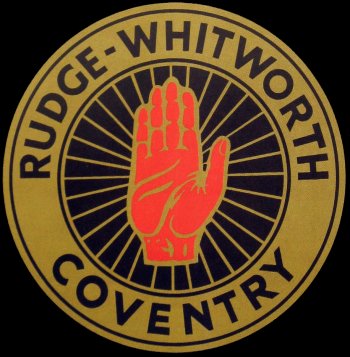





 |
|
| |
| |
| Droylsden Speedway |
| |
| Moorside Stadium, Droylsden, Manchester.
This cinder track got underway on 25th June 1927 so it certainly stakes a
claim as the UK's first speedway, but with council objections and poor
crowds Droylsden's life was not a long one. The last meeting was staged
20th April 1929. |
| |
| |
| Doddy's Trot |
| |
 |
| Picture courtesy of Ken Ward |
| |
| |
| Doddy's Trot |
| |
|
Ken Ward says: George Dodd, a local landowner
moved to the farm on Ashton Moss in 1920. His idea was to build a
training track for his horses. During this period he was entering horses
in events at the Nearby Audenshaw Trotting Stadium. |
|
|
|
His first attempt was quite small, then he
constructed a larger one nearby. As a Dirt track it was short lived. I
believe objections from the Local Authority stopped Speedway Riding at
Droylsden, their belief was that it was too dangerous, the quarter of a
mile straights allowed the Riders to get up too much speed to encounter
the bends. I am not sure but I believe Dirt Track riding at Droylsden
lasted from 1927 to 1929, I stand corrected on these dates. Ken |
| |
 |
| Picture courtesy of Ken Ward |
| |
| |
|
| |
| |
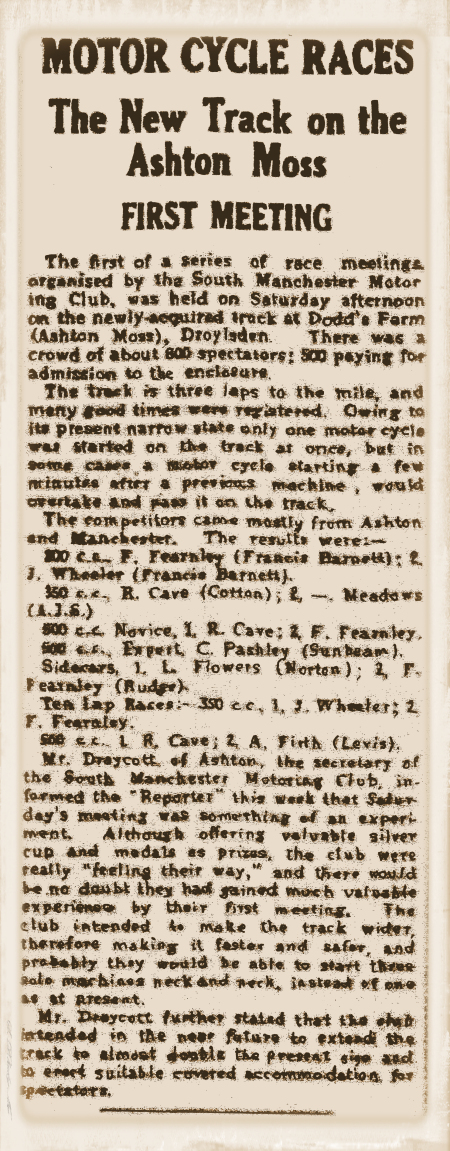 |
| Courtesy of Graham Gleave |
| |
| |
|
| |
| |
| The Snipe Inn |
| |
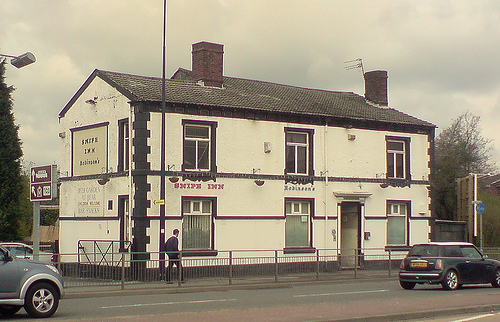 |
| Picture courtesy of Ken Ward |
| |
| Ken Ward says: Both the Droylsden and Audenshaw tracks
were behind the Snipe Inn. |
| |
| John says: That is amazing! We are talking a few hundred
yards yet one track was called Droylsden and the other Audenshaw.
The Snipe must have been frequented by both sets of spectators. |
| |
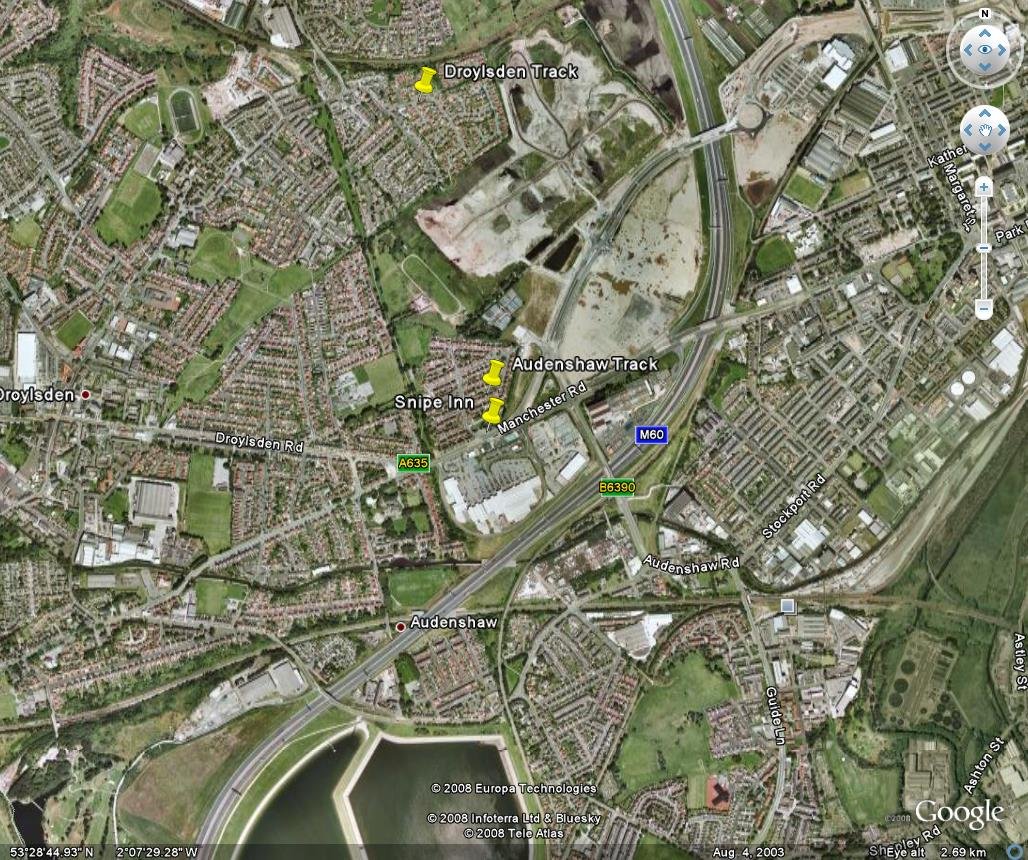 |
Courtesy of Google Earth
|
| |
|
Jack Longley sent this map of the area to illustrate how close Audenshaw
and Doylsden's tracks were
|
| |
 |
| Courtesy of Jack Longley |
| |
| This is where Droylsden's track used to be.
No evidence of one of the important homes of British Speedway |
| |
| |
|
| |
| |
| Droylsden Or High Beech? |
| |
| The Droylsden Incident! |
| |
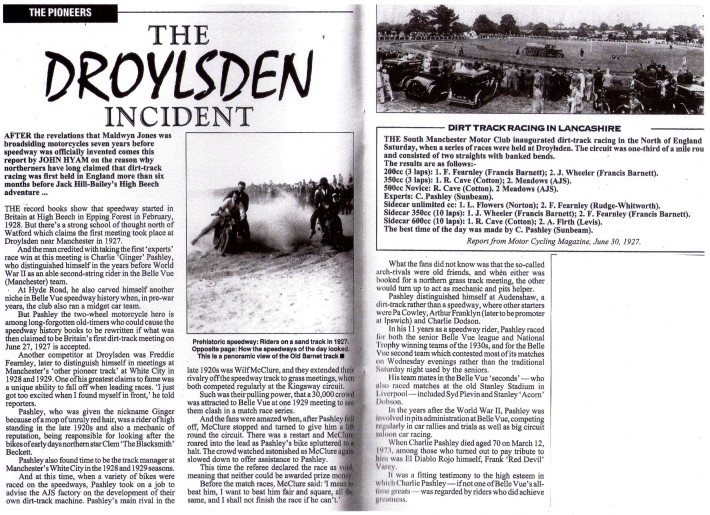 |
| Courtesy of John Hyam sent to me by
Graham Gleave |
| |
| You have to draw your own conclusion
about where speedway was first staged in the UK. I find the
item shown above to be of great personal interest to me as the
insert shows some of the British bikes used. |
| 200cc class Francis Barnett I think these
would be two stroke bikes possibly with a flywheel magneto
providing electricity for the spark plug |
| 350cc class Cotton and AJS |
| 500cc (modern speedway sized engine)
Cotton, AJS and Sunbeam |
| If only the British Bike Industry had
embraced speedway perhaps some of the great old names would still
be in business? |
| |
| |
|
| |
| |
|
Our Town Droylsden |
|
|
"The Life Of Riley"
Riskit Riley |
|
|
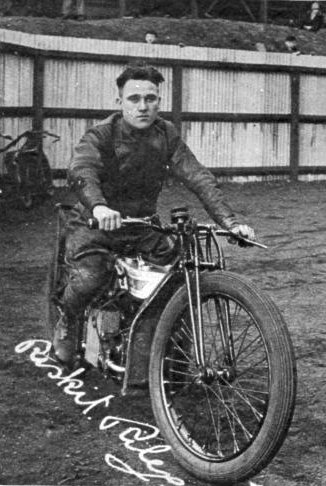
|
| |
| |
The Story Of The
Speedway Ace
Riskit
Riley |
|
|
|
By
Jeffrey Stafford |
|
|
|
In the late 1920s, dirt track racing quickly established
itself as a significant presence in the north west of England.
The region’s first post war race occurred on 25th
June 1927, at the newly constructed Moorside Stadium, Droylsden. This
meeting was organized by Harrison Gill of the South Manchester Motor
Club. Who was later associated with Belle Vue. The meeting was run on
a banked cinder circuit with racing being in an anti-clockwise
direction.
The owner was a
local farmer George Dodd, his idea was to build a trotting track for
his horses which he was racing at the nearby Snipe race track on
Ashton Old Road, Audenshaw.
Trotting
was a popular pastime in the district around Ashton as well as in
Stretford and Old Trafford.
However,
the local authority believed the Droylsdon track was much too
dangerous, the quarter mile straight track allowed riders to get up
too much speed to encounter the bends. |
|
|
|
Operations were suspended at Moorside Stadium after the last
meeting was staged on 20th April, 1929. It was at the half
mile track of the Audenshaw Racecourse, situated behind the Snipe Inn
that dirt track motorcycle riding really took off. The track was
active from 1928 to 1931. By today’s standards the track and its
safety features were very primitive, though this was not unique to
Audenshaw at the time. Prior to the first meeting on 3rd
March 1928, the track had been used for trotting and athletic events.
The riders averaged about 35 miles per hour.
Prizes ranged from Gold Watches to Canteens of Cutlery, and
Silver Cigarette Cases. Both Droylsden and Audenshaw were the breeding
grounds for many of speedways rising stars. |
|
|
|
The growing popularity of dirt
track racing soon resulted in the construction of many new tracks
designed specifically for racing motor cycles. Like the tracks at
Droylsden and Audenshaw many were carved out of old cow pastures and
fields. Some were located in natural amphitheatres with hill side
standing. The new dirt tracks varied in configuration, with many
continuing the half mile dirt track oval with variations of width,
straight, curve radii, and a degree of dirt banking. Many tracks were
designed by owners, promoters, and in some cases the riders
themselves. At many of the early tracks, the racing action could
easily overflow into the pits or into areas outside the track. There
were two short lived efforts to stage dirt track racing at Spring
Grove, Millbrook, Stalybridge; and New Mills Football Ground,
Derbyshire. |
|
|
|
It was not uncommon for riders to
race at weeknight and at the weekend.
The prize money was not very good, and so many riders travelled
from track to track to earn more, these riders quickly became
household names and local celebrities. For many dirt track fans at
early race meetings, the riders were heroes, and fans followed their
exploits of their favourite rider on and off the track, just as
football fans follow their favourite football player today. Many of
the track events in the early years were devoid of press coverage, so
apart from old programmes that have survived the test of time very
little is known. The same names would appear in the pioneer years of
dirt track race meetings. These included Ginger Lees, Frank Varey,
Slider Shuttleworth, Clem Beckett, the Drew brothers, and Hyde’s very
own Donald “Riskit”Riley. With a natural affinity for speed, “Riskit
“would show his “stuff” whenever he sat behind the controls of a motor
cycle, he was a real character on and off the race track and during
the late 1920s and early 1930s
became something of a real folk hero in his home town. |
|
|
|
Donald Francis Riley was born at
10 Hoviley Brow, Hyde, to James Riley and Clara Nuttall, who had
married at Ashton Registry Office in 1890. Donald was the youngest of
twelve children, seven sisters and four brothers, two of his sisters,
Winifred and Clara died before Donald was born in December, 1909.
Donald’s mother, Clara, died prematurely three years later in 1912,
aged 41. |
|
|
|
At
the age of 35 James Riley opened a shop selling fruit and vegetables;
this was the beginning of a thriving fruiter business which continued
to flourish up until 1942 when ill health forced him to close. After
finishing school, Donald entered the employment of his father, who in
the weekdays carried on his business at 10 Hoviley Brow, but on
Friday’s and Saturday’s, he also ran a fruit and vegetable stall on
Hyde Market where young Donald and his brothers helped out. He began
riding motor cycles at an early age and when dirt track riding became
all the rage in the north of England he wanted to try it.
According to one old speedway
pundit, Donald “Riskit” Riley got his first racing experience in 1928
as a fresh faced kid at the White City Stadium, Manchester. He would
have been about eighteen at
the time. He was just Riley then, dragging a heavy Norton round and
hoping for pot luck on the bends. That was until one day his father,
James Riley, went to see him in action, and he wasn’t over the moon
with what he witnessed. When Riley, senior, got home, he told Donald
he wasn’t impressed with what he had seen, and told is son as much.
“Call yourself a speedway rider! Why, you’re not fit to push them
off!” Donald set his jaw. “Ain’t I?” he said. Look here! If you can
win a heat, I’ll buy you a bike,” said Riley senior. Next time out
Donald won a heat, and true to his word Riley senior stumped up the
cash for a new Douglas. By no stretch of the imagination could you
call young Riley a consistent rider. But when he got that spark of
inspiration he was a match for anyone. It was full throttle to the
line, with no thought of personal danger. |
|
|
|
The first use of Riley’s famous
nickname is to be found in a Speedway Programme for a meeting at
Audenshaw in 1929. He allegedly got his nickname riding the “Wall of
Death” at Belle Vue, but whether this is true is open to debate.
Inventing nicknames for riders, especially in the early days of the
sport, such as “Riskit Riley”, was one way to sensationalise the
sport. So when you’re a dirt track rider whose last name is Riley, and
you’re taking spectacular risks on the dirt track, you really don’t
have much choice: you have to be “Risket Riley”.
The name stuck throughout his
career and separated his fairly common name from the rest of the herd.
“Riskit” wore a type of lace up metal shod clog which came up above
the ankle bone. These acted like steel skates on corners. This was at
a time when most of the early dirt track riders wore hob nail boots
with a steel toe cap. |
|
|
|
Speeding
on the highways landed “Riskit” in court
on more than one occasion.
The Hyde Reporter: Saturday 13th
April, 1929, ran the story as follows:- |
|
|
|
|
|
King Street Speedway
|
|
|
|
Dirt Track Rider Fined |
|
|
|
Donald Riley, a
fruitier, of
Hoviley Brow, Hyde, well known in the district as the dirt track rider
“Riskit” Riley, was summoned at Dukinfield Police Court on Thursday,
for driving a motor cycle and combination in a dangerous manner. |
|
|
|
Inspector Murray stated that at
11-5 a.m. on Good Friday, he was on King Street, near the Queen’s Arms
Hotel, when a motor cycle came along from the direction of Ashton.
Visibility was bad owing to the fog, and it was impossible to see more
than 80 yards ahead. When the motor cycle was approaching King Street
and Wharf Street crossing the motor cycle combination, driven by
Riley, came past at a fast pace. He put up his hand and the defendant
pulled up over ten yards away. He told defendant he was driving too
fast and asked him for his driving license. He was unable to produce
it and stated he could not take it to the police station the same
afternoon, because he was riding at White City, Manchester. The
inspector replied “I think you are making this street into a practice
track.” Inspector Murray added that in his opinion defendant was
driving dangerously, and he trembled to think what would have happened
if anyone had attempted to cross the street. |
|
|
|
In reply to the defendant the
Inspector said he estimated the defendant’s speed over the cross roads
at 25 miles per hour. William Lees, of Church Street,
said defendant never sounded his horn, and he agreed with the police
that the speed was dangerous at that particular point. Defendant said he was only
driving at 15 miles per hour, and he could have pulled up much quicker
had he thought the Inspector desired him to do so. |
|
|
|
Numerous speeding offences were
recorded against Riley, Superintendent Brown stating that he had been
fined £10 at Mottram and his license suspended for twelve months for
dangerous driving.
The magistrate now fined Riley
40s, and suspended his license for six months Defendant: Does that mean I
cannot ride on the dirt track?
The
Clerk: You had better see a solicitor. |
|
|
|
In 1929 Riley became acquainted
with 19 year-old Mabel Kisswetter, the daughter of a German immigrant,
they commenced a tumultuous relationship, climaxing in a March
marriage, at Chorlton on Medlock Registry Office in 1930. Their son,
James (Jimmy) was born in 1931. Jimmy is today
81 years old, and lives with
his wife Margaret in Manchester. |
|
|
|
Although Mabel had been courting
Donald for the best part of a year, she had no idea that he had been
having an affair with a girl from his home town of Hyde called Gladys
Mottram. They had been seeing each other for about eighteen months,
going for motorcycle trips to
Blackpool and the outskirts of the Hyde, where there were still many
quite lanes and secluded spots for young courting couples.
|
|
|
|
In 1929 “Riskit” established
himself as one of the top young dirt track riders in the country. At
Belle Vue Speedway track on Hyde Road on Saturday, 1st June
1929 he won the Golden Gauntlet, his first major prize. |
|
|
|
The
Hyde Reporter of Saturday June
8th 1929 had this to say:- |
|
|
|
|
|
Dirt Track Racing |
|
|
Riley’s Success
At Belle Vue |
|
|
|
Followers of dirt track racing
will learn with pleasure of the success of Donald Riley, son of James
Riley, fruiterer, of Hoviley Brow, Hyde, at Belle Vue Speedway on
Saturday, when he won the Golden Gauntlet, his first big prize.
“Riskit” Riley has he is known on the tracks, returned two of the best
times of the night, 1/30.9 and 1/31.5. In addition to winning the
Golden Gauntlet, he was also successful in the BelleVue Handicap.
Riley is still only 19 years of age, and is said by leading speedway
critics to have a great future on the racing track. Riskit climbed the
podium for the second time on Saturday 20th July, when one
of the largest crowds assembled at Belle Vue Speedway Stadium witness
Riley give another display of supreme skill and speed in the mile race
to win the premier prize, the golden helmet. |
|
|
|
The Hyde Reporter also had this to
say:- |
|
|
|
Golden Helmet |
|
|
|
"Riskit" Riley's Double
Success |
|
|
|
Donald Riley, known on the dirt
track as “Riskit Riley,” of Hoviley Brow, Hyde, achieved further
successes at Bell Vue Speedway on Saturday. In the mile race he won
the premier prize, the golden Helmet, given by the Manchester Motor
Club, with a fine performance, in which all scratch riders took part.
He is now regarded as one of the “stars” of the Belle Vue track, for
Arthur Franklin and Frank Varey, both men of repute, are the only
riders to secure this trophy. Riley the previous Wednesday beat
Franklin, a very difficult thing to do. In his heat Riley put up the
fastest time of the evening, covering the mile in 1min. 28.4 secs. |
|
|
|
He also won the Belle Vue
Handicap in which there were some clever riders, he being the only
scratch man. He beat Hurricane Hatch and George Corney, of Halifax,
who only recently returned from Hamburg. Riley a few weeks ago won the
golden gauntlet also for the mile scratch race, but he has never
ridden better than he did on Saturday. |
|
|
|
His success is the more
remarkable when it is pointed out that this is his first season as a
dirt track rider, that he is only 19 years of age and has only been
racing since March. He has completed against such well known experts
as Frank Arthur, the Australian, of the International Speedway
Company, and has won a good number of prizes. He is a fearless rider
and keeps good control of his machine. |
|
|
|
I think it’s fair to say that by
the close of the 1929 Speedway Season, Riley had the speedway world at
his feet. However, his burgeoning dirt track career seemed to rise in
conjunction with his capacity for getting in trouble. |
|
|
Former Hyde Road
Dirt Track Rider
Bound Over |
|
|
|
Donald Riley, otherwise known as
“Riskit” Riley, of dirt track fame and residing in Thorncliff Grove,
Chorlton on Medlock, was bound over for 12 months at Manchester City
police court, on Thursday, on a charge of having obtained £1 by false
pretenses from Mr. Wilfred Blundell of Smithfield Market. It was explained that Riley went
to Mr.Blundell and represented falsely that he had been sent for money
by his father for motor parts. |
|
|
|
Riley’s father said his son had
done no work since leaving school. He had spent £200 in furnishing him
with two motor cycles for dirt track riding. |
|
|
|
For a time his son had done
exceedingly well in that sport. Answering his son, Mr.Riley said
it was true that though he had won about £500 at Belle Vue last year
he had to pay a mechanic £5 a week and his machines cost a lot in
repairs. His son had also got into bad
company, and had concentrated debts by borrowing which he had to
repay. |
|
|
|
On being appealed to by his son
from the dock, the senior Mr.Riley said he would repay the £1 mentioned in the
charge.
Riskit was also fined 10shillings for
having sounded his motor horn when not necessary on the ground of safety. |
|
|
|
Riskit’s freewheeling lifestyle
finally caught up with him again a month later, when he his
ex-girlfriend Gladys Mottram hauled him up before Hyde Police Court on
a paternity charge.
|
|
|
|
|
|
Riskit Riley's Blackpool Trip |
|
|
|
A Girls Amazing Evidence |
|
|
|
Well known speedway rider Donald Riley,
15 Thornton Avenue, Oxford Road, Manchester, was the defendant at
Hyde Court, on Thursday, in a case in which Gladys Mottram, age
nineteen, 119 Croft Street, Hyde, applied for an order of paternity in
respect of a male child born on August 23rd. |
|
|
|
Mr.John Westbrook, solicitor,
Hyde, appeared for the complainant. Mr.Harold Bostock, solicitor,
Hyde, appeared for the defendant, who denied paternity. |
|
|
|
Mr.Westbrook said that the
defendant was a professional dirt track rider, well known in the town
as “Riskit Riley”. He thought when the magistrates had heard the
evidence that they would agree he showed a considerable amount of
effrontery in denying the paternity of the child. |
|
|
|
The parties first met eighteen
months ago. Subsequently they met several times, and in October, 1929,
the defendant and his friend met complainant and her friend-Miss
Taylor, in Hyde, and they all went to Blackpool to see the
illuminations in the defendant’s motor car. On the way back, on
Belmont , intimacy took place. |
|
|
|
Defendant lived in Hyde with his
father, who was a well known tradesman, but left and she did not know
his address. When he found that she was making enquiries about him, he
saw her, and said “If I am the father I am the father, and we shall
have to see how things turn out.” He said if he had not been married
he would have married her. That was the first time Miss Mottram knew
that he was married. He was married after the association with the
complainant. Mr.Westbrook said that the defendant persuaded the
complainant to see a person in Ashton who, he said, could do something
for her. |
|
|
|
On the Hyde Carnival night in
June, the defendant went to see the complainant at her home, and told
her that his wife was “expecting” and he did not want her to know
anything about the matter. He saw her parents, and frankly admitted
the paternity, and said that he would see what could be done when the
child was born. Later he approached Miss Taylor, the complainant’s
friend, on two occasions with the object of keeping her out of court.
Once he offered her money if she would stay away from court or give
evidence for him. She indignantly repudiated the suggestion. The clerk
of the court: That is a rather serious offence. |
|
|
|
|
|
The Woman In Ashton |
|
|
|
Gladys Mottram then described the
various meetings with Riley. She and her friend met Riley and his
friend at Broomstair Bridge on the occasion of the Blackpool trip.
Speaking of the visit of Riley to her home she said he sent a young
woman to the door, and she came out to him. He said “If I am the
father I am the father, but I can’t marry you, as I am already
married.” He told her about a woman in Ashton , and she went with him.
The woman told her that she was not the only one he had taken to her.
On carnival night, when he went to her home, he said to her “Don’t
forget if it’s a little boy, call it after me.” She replied “If it
turns out to be like you I will drown it.” Riley left, and returned
when her father and mother were at home. He asked her mother to lend
him ten shillings and he would give her a pound for it the following
Monday. Her mother could not let him have the money, and asked him
what he thought about himself. He replied “I admit that it is my
child.” She told him that he should have thought about that before he
got married. He told her that he did not want to go to court. |
|
|
|
Her confinement expenses, she
said, were two guineas doctor’s fee two guineas for the nurse, and 23
shillings and sixpence for baby clothes. She had special nourishments. |
|
|
|
|
|
Couldn't Put Riley In The Witness Box |
|
|
|
Mr. Bostock asked the magistrates
leave to speak in private to his client, who was accompanied by his
wife. After a short absence Mr. Bostock told the magistrates that after
his conversation with his client he was not in a position to
put him in the box, and he could not really oppose the order.
Kathleen Taylor, 3 Hall Street,
Kingston, gave corroborative evidence. She said that Riley offered her
money to stay out of court. |
|
|
|
Mr. Bostock said that the case
resolved itself into a question of means. Defendant as a dirt track
rider was highly successful until twelve months ago. Since then he had
not been riding regularly, and had only appeared at meetings on
Sunday; there was no appearance money, and he had to win or get
nothing. During the whole of the year he had won £32in prize money,
and had to borrow a motor cycle to appear. His agreement with the
owner was for half the winnings, and he had to bear half the cost of
repairs and conveyance. His net earnings were £3 10s for the period.
He was not in the employment of any dirt track company. He was married
on 4th January this year, and had resided with his wife and
her parents for nearly the whole of the period, and was dependent for
his keep on his wife and her parents. He was doing some work on Hyde
Market, but had not a regular wage, and his receipts from that source
did not amount to more than ten shillings per week. |
|
|
|
Mr. Westbrook said that in view of
what Mr. Bostock had said, he was entitled to point out that during
certain proceedings in September, the defendant stated in court that
his earnings last year from dirt track riding were £500, and he had to
pay £3 per week for a mechanic out of that. The magistrates made an order of
10s per week until the child reaches 16 years of age, and allowed £8
expenses and two guineas advocate’s fee, and witnesses expenses. |
|
|
|
After the scandalous revelation
that he had fathered an illegitimate child and tried to procure a back
street abortion in Ashton, Riley’s personal difficulties increased.
His stormy tempestuous union
with Mabel Kisswetter ended on the sharpest of rocks. He was pursued
through the court for years for child maintenance, and in May 1931
sent to prison for fourteen days for obtaining 5s by false pretenses,
with intent to defraud. The Chief Constable said Riley was a married
man living apart from his wife and they were holding over a commitment
in respect of arrears under an affiliation order until after that case
was heard. Riley was very unsatisfactory and had previously been bound
over on a charge of false pretenses. |
|
|
|
|
|
Riskit's Death! |
|
|
|
Donald Francis “Riskit” Riley
died in 1951 in Manchester, a lonely, broken man – estranged from his
family and speedway, he was 41 years old. A sad ending to a remarkable
but troubled life.
It was his
inability to separate his domestic problems from his professional
speedway career that prevented him from reaching his true potential on
the dirt track. |
|
|
|
Although it is seventy year since
“Riskit” stood selling fruit and veg on Hyde Market for his father, he
is still fondly remembered by many old Hydonians. Hyde’s produced
several so called sports personalities: swimmers, soccer players,
athletes and boxers, but all pale in comparison to speedway ace Donald
“Riskit” Riley, on and off the track he lived his life to the full, he
was the Errol Flynn of speedway. Though his speedway career may have
been relatively short, he is still fondly remembered as one of the
most colourful characters from the early days of dirt track racing in
Manchester. |
|
|
|
|
|
|
|
If you have any photos programme/badge scans or stories to
share please send me an
email |
|
|
|
|
The contents of the site are © and should not be
reproduced elsewhere for financial gain. The contributors to this site
gave the pictures and information on that understanding. If anyone has
any issue or objections to any items on the site please
e-mail
and I will amend or remove the item. Where possible credit
has been given to the owner |

